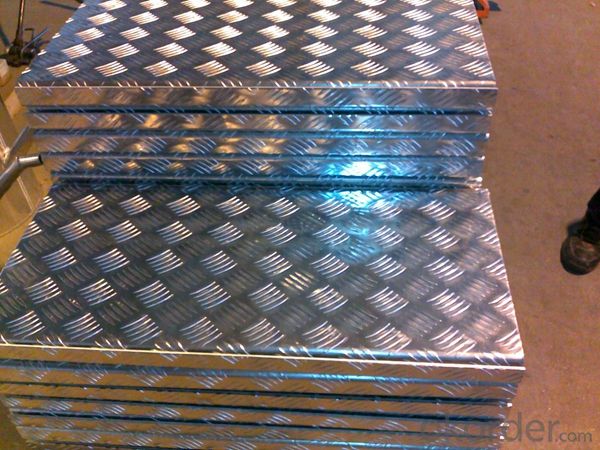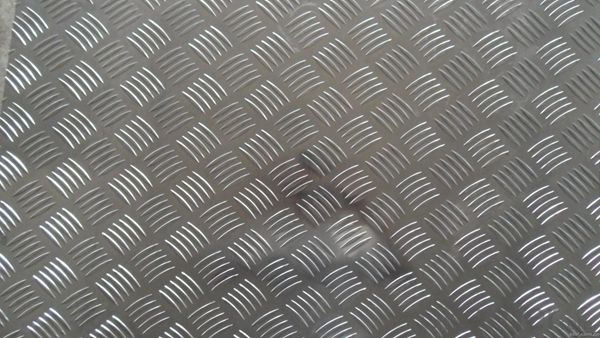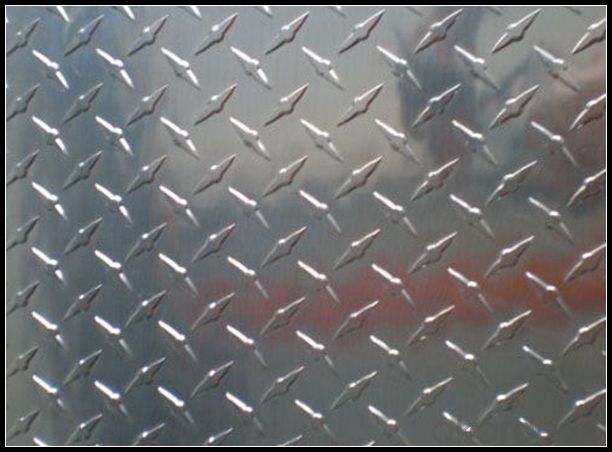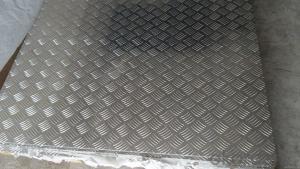Mill Finish Embossed Five Bar Aluminum Sheet
- Loading Port:
- Shanghai
- Payment Terms:
- TT OR LC
- Min Order Qty:
- 5 m.t.
- Supply Capability:
- 10000 m.t./month
OKorder Service Pledge
OKorder Financial Service
You Might Also Like
Item specifice
1. Specification of Mill Finish Embossed Five Bar Aluminum Sheet
EQUIPMENT | Double coating double baking; |
CAPACITY | 5000Mt/week |
SIZE | Thickness 0.18mm—2mm, width 40mm—1250mm |
PAINT THICKNESS | Top:18--25um, back:5-7um |
COIL WGT | 3Mt - 8Mt |
COIL ID | φ508mm,φ610mm |
SURFACE PAINT | EP, PE, HDP, SMP, PVDF |
COLOR SERIES | RAL color number series |
2. Application of Mill Finish Embossed Five Bar Aluminum Sheet
(1).Interior: wall cladding, ceilings, bathrooms, kitchens and balconies, shutters, doors...
(2).Exterior: wall cladding, facades, roofing, canopies, tunnels,column covers , renovations...
(3).Advertisement: display platforms, signboards, fascia, shop fronts...
3. Feature of Mill Finish Embossed Five Bar Aluminum Sheet
Surfact Quality :
Be free from Oil Stain, Dent, Inclusion, Scratches, Stain, Oxide Dicoloration, Breaks, Corrosion, Roll Marks, Dirt Streaks and other defect which will interfere with use,
Mechenical Property:
Chemical Composite and Mechanical Property
4. Certificate:
SGS and ROHS(if client request, paid by client), MTC(plant provided), Certificate of Origin(FORM A, FORM E, CO), Bureau Veritas and SGS (if client request, paid by client), CIQS certificate
5. Image of Mill Finish Embossed Five Bar Aluminum Sheet



6. Package and shipping of Mill Finish Embossed Five Bar Aluminum Sheet
First, plastic cloth with drying agent inside; Second, Pearl Wool ; Third, wooden cases with dry agent , fumigation wooden pallets, aluminum surface could cover blue PVC film


7. FAQ
1) What is the delivery time?
Dpends on actual order, around 20 to 35 days
2)What is the QC system:
We have QC staff of 20 persons and advanced equipment, each production is with MTC traced from Aluminum ingot lot.
3) What market do you mainly sell to?
Australia, America, Asia, Middle East, Western Europe, Africa etc
- Q:How are aluminum sheets tested for quality and compliance with industry standards?
- Quality and compliance with industry standards for aluminum sheets are ensured through a comprehensive range of tests and inspections. These tests guarantee that the desired specifications and performance criteria are met by the sheets. Visual inspection is one of the commonly utilized tests, where the sheets are thoroughly examined for any surface defects like scratches, dents, or cracks. This examination is crucial to ensure a flawless and smooth appearance. Furthermore, dimensional checks are carried out to verify the thickness, width, and length of the sheets. Precise measurements are essential to meet the specific requirements of the intended application. Various tests are conducted to evaluate the mechanical properties. Tensile strength tests assess the maximum load the aluminum sheet can bear before breaking. This aids in determining the structural integrity of the sheet and its ability to withstand external forces. Similarly, hardness tests measure the sheet's resistance to indentation or penetration, providing insights into its durability and resistance to wear. Chemical composition analysis is also undertaken to ensure that the aluminum sheets contain the necessary alloying elements within the specified limits. This analysis helps confirm that the material composition aligns with industry standards, as different alloy compositions can affect the mechanical properties of the sheets and their suitability for various applications. Corrosion resistance tests assess the sheet's capacity to withstand environmental factors like moisture, chemicals, and temperature variations, thereby evaluating its surface integrity. This evaluation is particularly important for applications where aluminum sheets are exposed to corrosive substances or harsh environments. In addition to these tests, non-destructive testing techniques such as ultrasonic testing or eddy current testing may be employed on aluminum sheets. These methods help identify internal defects or irregularities that may not be visible through visual inspection alone. Overall, a combination of visual inspections, dimensional checks, mechanical tests, chemical composition analysis, and surface integrity evaluations are utilized to ensure that aluminum sheets meet the quality standards and compliance requirements set by the industry. These rigorous testing procedures guarantee that the sheets are suitable for their intended purpose and fulfill the expectations of customers.
- Q:Can aluminum sheets be used for decorative ceilings?
- Indeed, decorative ceilings can utilize aluminum sheets. The versatility of aluminum allows for the creation of a multitude of designs and patterns, resulting in visually pleasing ceilings. Its lightweight nature, durability, and resistance to corrosion make it a favored choice for decorative purposes. Furthermore, aluminum sheets can be powder-coated or painted in various colors, enabling them to align with the desired aesthetic of any given space. Regardless of whether the purpose is residential or commercial, aluminum sheets provide a contemporary and fashionable option for crafting decorative ceilings.
- Q:I need to fix some connections at my dad's house. The original wiring is aluminum, but the newer stuff he did is copper. Simple wire nuts will not suffice. Already had one melted one. I need to fix the connections, but need an economical, safe way of doing it. Suggestions?
- Replace all the wires into copper. Risk of fire as copper joints with aluminum or cause intermittent problem use on heavy current load. Because copper twists joint with aluminum create thermo effect. Aluminum wire was abandoned for house wiring long long time ago.
- Q:Are aluminum sheets suitable for high-temperature applications?
- High-temperature applications are generally not suitable for aluminum sheets. Despite its relatively high melting point of 660.3°C (1220.5°F), the strength and mechanical properties of aluminum decrease significantly as the temperature rises. Aluminum tends to soften, deform, and lose its structural integrity at elevated temperatures. Moreover, its relatively low thermal conductivity hinders efficient heat conduction away from the source, resulting in potential overheating problems. Hence, stainless steel or refractory metals like titanium or tungsten are commonly preferred for high-temperature applications due to their superior performance and thermal conductivity.
- Q:What are the different forming methods for aluminum sheets?
- There are several different forming methods that can be used to shape aluminum sheets. These methods include: 1. Roll Forming: This process involves passing the aluminum sheets through a series of rollers that gradually shape the material into the desired form. Roll forming is often used to create long, continuous shapes such as channels or rails. 2. Press Forming: Press forming uses hydraulic or mechanical presses to apply force to the aluminum sheet, creating the desired shape. This method is commonly used for forming complex shapes with tight tolerances. 3. Stretch Forming: In stretch forming, the aluminum sheet is clamped at its edges and then stretched over a die, causing the material to conform to the shape of the die. This method is often used to produce curved or contoured parts. 4. Deep Drawing: Deep drawing involves placing a blank of aluminum sheet into a die and then using a punch to force the material into the die cavity, creating a hollow shape. This method is commonly used to produce cylindrical or box-shaped parts. 5. Hydroforming: Hydroforming uses hydraulic pressure to shape the aluminum sheet against a die. This method is particularly useful for producing complex, intricate shapes with smooth surfaces. 6. Incremental Sheet Forming: In incremental sheet forming, a CNC machine moves a small tool over the surface of the aluminum sheet, gradually shaping it by applying localized pressure. This method is often used for prototyping or small-scale production. These forming methods offer different advantages and are suitable for different applications. The choice of method depends on factors such as the desired shape, complexity, and volume of production.
- Q:What is the electrical resistivity of 101 aluminum sheets?
- The electrical resistivity of aluminum sheets, totaling 101 in number, can fluctuate based on the grade and condition of the aluminum. On average, the electrical resistivity of aluminum is approximately 2.65 x 10^-8 ohm-meters. It should be emphasized that this value may experience slight variations due to impurities or other factors.
- Q:Can aluminum sheets be welded or soldered?
- Aluminum sheets have the capability to undergo both welding and soldering processes, although the techniques for each differ significantly. When welding aluminum, a TIG (Tungsten Inert Gas) or MIG (Metal Inert Gas) welding process is typically employed, necessitating a high heat source and a filler material to connect the sheets. This process is generally more demanding when compared to welding steel due to aluminum's high thermal conductivity and lower melting point. On the other hand, soldering aluminum involves utilizing a low-temperature solder and flux to bond the sheets together. Usually, specialized solders like aluminum solder or solder with a high tin percentage are employed. Soldering aluminum is typically less prevalent and more intricate than soldering other metals due to the presence of an oxide layer on aluminum, which hinders proper adhesion. To summarize, while both welding and soldering can be utilized for joining aluminum sheets, welding is the more commonly employed method due to its superior strength and durability. Soldering aluminum presents additional challenges due to the requirement for specialized solders and the presence of the oxide layer.
- Q:What is the maximum temperature that the aluminum sheets can withstand?
- The specific grade of aluminum used determines the maximum temperature that aluminum sheets can endure. In general, most aluminum alloys maintain their structural integrity up to temperatures ranging from 600 to 650 degrees Fahrenheit (315 to 343 degrees Celsius). However, it is crucial to recognize that extended exposure to high temperatures may result in aluminum weakening, deforming, or even melting. Consequently, it is advisable to refer to the manufacturer's specifications or testing data for the particular aluminum grade in order to ascertain its maximum temperature tolerance.
- Q:Can aluminum sheets be used for flooring?
- Indeed, flooring can utilize aluminum sheets. Lightweight and sturdy, aluminum proves resistant to corrosion, rendering it an appropriate option for a range of flooring uses. Notably, aluminum sheets frequently find employment in industrial, commercial, and residential settings, encompassing warehouses, garages, kitchens, and outdoor areas. These sheets offer commendable strength, effortless installation, and minimal upkeep. Furthermore, aluminum flooring imparts a polished and contemporary aesthetic to any given space. Nevertheless, prudent consideration of factors like thickness, finish, and the unique demands of the flooring project becomes imperative prior to settling on aluminum sheets.
- Q:Are aluminum sheets suitable for solar panel applications?
- Yes, aluminum sheets are suitable for solar panel applications. Aluminum is lightweight, durable, and has excellent thermal conductivity, making it an ideal material for solar panel frames and backsheets. It is also corrosion-resistant, cost-effective, and widely available, making it a popular choice in the solar industry.
1. Manufacturer Overview |
|
|---|---|
| Location | |
| Year Established | |
| Annual Output Value | |
| Main Markets | |
| Company Certifications | |
2. Manufacturer Certificates |
|
|---|---|
| a) Certification Name | |
| Range | |
| Reference | |
| Validity Period | |
3. Manufacturer Capability |
|
|---|---|
| a)Trade Capacity | |
| Nearest Port | |
| Export Percentage | |
| No.of Employees in Trade Department | |
| Language Spoken: | |
| b)Factory Information | |
| Factory Size: | |
| No. of Production Lines | |
| Contract Manufacturing | |
| Product Price Range | |
Send your message to us
Mill Finish Embossed Five Bar Aluminum Sheet
- Loading Port:
- Shanghai
- Payment Terms:
- TT OR LC
- Min Order Qty:
- 5 m.t.
- Supply Capability:
- 10000 m.t./month
OKorder Service Pledge
OKorder Financial Service
Similar products
New products
Hot products
Related keywords





























